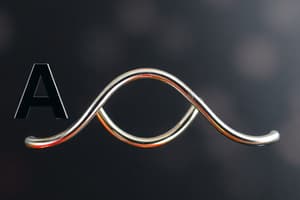Podcast
Questions and Answers
What are the lesson objectives regarding metallic bonds?
What are the lesson objectives regarding metallic bonds?
- Describe how metallic bonds form
- Identify alloys and their uses
- Relate the nature of metallic bonds to the properties of metals
- All of the above (correct)
What is an alloy?
What is an alloy?
A mixture of metals with one or more other elements.
What is a metallic bond?
What is a metallic bond?
The force of attraction between a positive metal ion and the valence electrons it shares with the other ions.
The positive ions form a ______ structure.
The positive ions form a ______ structure.
The properties of metallic bonds may resemble those of a rigid ionic crystal.
The properties of metallic bonds may resemble those of a rigid ionic crystal.
What happens to the positive ions of metals when they are surrounded by the 'sea' of electrons?
What happens to the positive ions of metals when they are surrounded by the 'sea' of electrons?
Give examples of alloys.
Give examples of alloys.
Flashcards are hidden until you start studying
Study Notes
Metallic Bonds Overview
- Metallic bonds result from the attraction between positively charged metal ions and their shared valence electrons.
- The lattice structure formed by positive ions is essential for maintaining these bonds.
Formation of Metallic Bonds
- Positive metal ions create a lattice framework held together by bonds with valence electrons.
- This structure enables flexibility and movement of ions without rupturing the bonds.
Properties of Metals
- Metals may exhibit a rigid structure similar to ionic crystals.
- Freely moving electrons contribute to high electrical conductivity, making metals excellent conductors.
Alloys
- Alloys are combinations of metals mixed with one or more other elements.
- Common examples of alloys include steel, bronze, and brass, which enhance the properties of pure metals.
Conductivity and Malleability
- The "sea" of delocalized electrons allows metals to conduct electricity effectively.
- The mobility of positive ions permits metals to be reshaped (malleable) without breaking their metallic bonds.
Summary
- Metallic bonding creates a structure where ions are held together by shared electrons, allowing for conductivity and malleability.
- The combination of metals into alloys often yields materials with superior qualities compared to pure metals.
Studying That Suits You
Use AI to generate personalized quizzes and flashcards to suit your learning preferences.




